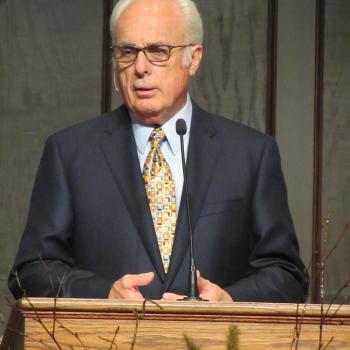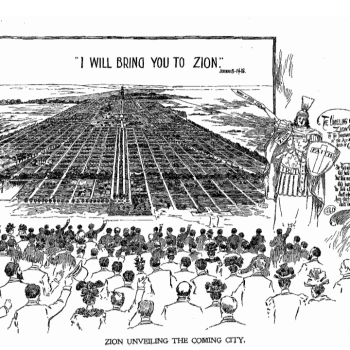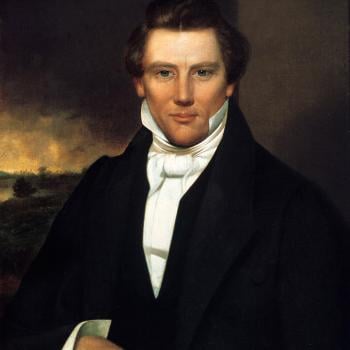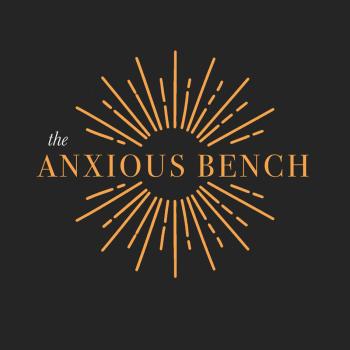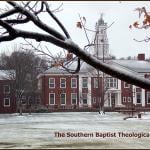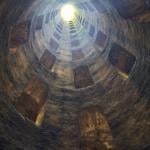I’m re-posting the below, which originally appeared in two separate segments at Religion in American History:
After years of studying the history of Mormonism, I finally resolved to read the tradition’s founding scripture in short order: the Book of Mormon in fifteen days. Because of its large print and easy-to-read format (I’m not quite as old as that makes me sound), I chose Royal Skousen’s The Book of Mormon: The Earliest Text (Yale, 2009) for the task. I’ve also kept Grant Hardy’s Understanding the Book of Mormonas a reference guide.
So that I can fit it in a blog post, here’s a very short commentary on each book (I gave myself only fifty words per book).
1 Nephi. Major action here — Lehi’s family flees Jerusalem, takes a boat to the “land of promise.” Of note: plates, Christ, dark skin as a curse, visions (of Christ “above that of the sun at noonday”), stock characters, prophecies about the New World. Finally, I understand the “Sword of Laban” references.
2 Nephi. Lehi blesses his children, die. Dark skin = God’s curse, emphasis upon free agency, allusions to Joseph Smith and the Book of Mormon, almost constant prophecies about Christ. Why did Nephi have access to Isaiah in the KJV? 2 Nephi 2 my favorite passage in BOM.
Jacob (Nephi’s brother). After two long books, five light days of Mormon scripture reading. Nephi dies. Jacob has visions, issues prophecies. Don’t take concubines or additional wives! If only God had not permitted the wiggle room of Jacob 2:30. False prophet Sherem refuted by Jacob, recants, dies. Jacob dies.
Enos (Jacob’s son). 27 verses only. Gets plates from his father. Lamanites (descendants of Lehi’s sons Laman and Lemuel and others opposed to Nephi’s descendants) have shaved heads, wear only “a short skin girded about their loins,” and only eat raw meat. Nephites raise grain, fruit, and flocks. Prophecies of coming wars.
Jarom (Enos’s son). Gets plates from his father (who with his fathers revealed “the plan of salvation”). Lamanites “drink the blood of beasts.” Nephites fight them off.
Omni (Jarom’s son). Plates passed down, eventually come to Amaleki. Mosiah flees to the land of Zarahemla and there becomes king. The ancestors of the Zarahemlans also left Jerusalem at the time of its destruction. Mosiah helps the Zarahemlans find a man named Coriantumr, whose knowledge stretches back to the Tower of Babel.
Mormon. New narrator. Major editor of the entire BOM. King Benjamin = righteous. Now we are moving on from the plates of Nephi. Wish Mormon had announced himself as editor from the get-go. [Yes, there’s an explanation for that].
Mosiah. (Done with tiny books). Mosiah inherits power from his father King Benjamin. Expedition by some Nephites back to their old land, encounter with Limhi. Excursus through Record of Zeniff. Great heroes and villains in this book. Mosiah rejects monarchy at end of book — elections are held.
Alma. 63 chapters! Hundreds of pages in Skousen’s edition! Alma entirely derailed my plans. I was overconfident after reading Enos, Jarom, Omni, and the Words of Mormon. I was ahead of schedule when I finished Mosiah. Alma, though, did me in. Alma did me in. In my edition (Royal Skousen’s Earliest Text), Alma takes up two hundred and thirty pages. It stopped my reading schedule in its tracks.
Eventually, I set aside six days for Alma, and it was then easy to read the remainder of the scripture in short order. Continuing my approach from the first post, here are summaries of the remaining books in fifty words or fewer.
Alma. A really long book. Priests good; priestcraft bad. Did “whosoever did mingle his seed with that of the Lamanites did bring the same curse upon his seed” influence later LDS concerns over intermarriage? Alma foregoes his judgeship to focus on his priestly duties; seems anti-theocratic. Lamoni’s apparent death fascinating.
Helaman. Growth of Gaddianton societies, robbers with signs and secret words. At the end of Helaman, a Lamanite prophet named Samuel announces that Christ’s coming is near, will be accompanied by signs. God will destroy all Nephites, but not utterly destroy the Lamanites.
3 Nephi. Christ comes. Miraculous signs accompany Christ’s birth. Many believe, then fall away a few years later. Gaddianton soldiers with shaved heads, headplates, lambskin dyed in blood. Destruction at time of Christ’s death. Zarahemla burned. Jesus appears, will appear to other “sheep.” Three Nephites: somewhere between moratlity and immorality.
4 Nephi. Best of times: “neither there were Lamanites nor no manner of ites.” People live long lives. After two hundred years, unity dissolves amid growing riches and pride. Building up of different apostate churches.
Mormon. As boy, told to find sacred engravings in a hill at age 24. Mormon “tasted and knew of the goodness of Jesus.” After terrible defeats, Mormon gathers the Nephites to the hill Cumorah, where he hides the records, save for a few plates given to son Moroni.
Ether. Fascinating excursus. Book is about the Jaredites, a people who travel to the “land of promise” in barges illuminated with stones of light. Brother of Jared sees the finger of the Lord; turns out to be the incarnate Christ. Last surviving Jaredite is Coriantumr. Interesting doctrine about Jesus Christ first existing in a “body of … spirit,” prior to incarnation.
Moroni. Teachings about laying on of hands, ordination, administering “the flesh and blood of Christ unto the Church,” and baptism. Sermon of Mormon. Letters of Mormon to Moroni. Miracles haven’t ceased. Moroni seals up the record. Ask God if the things in this book are true.

A few thoughts:
– Some people read the BOM with the goal of refuting its claim to be an ancient record, for instance, by looking for reflections of Jacksonian age American culture within the text. Others read it while praying that they would know whether the BOM is the word of God. I didn’t approach the text with either of those reading strategies. I’ve been reading simply to get a sense of the overall narrative, the narrators, and the themes. This is a really good idea if one teaches courses that include material on Mormonism.
– Even from the bits I’d read previously and from what I’ve read in secondary sources, I knew that the BOM is heavily christocentric. Still, it’s even more christocentric than I presumed. It’s overwhelmingly christocentric. Detailed prophecies about Jesus all the time. I find the BOM to be persistent and exuberant in its insistence upon the divinity of Jesus Christ, whom it sometimes identifies as “the Father and the Son.”
– While brushing up on Jewish, Christian, and Muslim scripture for my introductory classes on Abrahamic religions, I’ve been thinking about the composition, construction, and ongoing interpretation of scripture. The textbook I use (Jews, Christians, Muslims by Corrigan, et al.) emphasizes the role of community in turning words and books into scripture. Even if it is what it claims, the BOM’s textual history is incredibly different. No one in the United States or elsewhere had read it when it “came forth” in 1830. The BOM was a book claiming to be scripture, and then it became scripture when Joseph Smith’s relatives and then a whole host of individuals accepted its claims. On a much more superficial level, I was thinking about why certain passages in either the Bible or the BOM “sound like” scripture to me. It may or may not have much to do with inherent beauty or narrative power. More likely, I think, when one sits in congregations and Bible studies and hears the same stories and poems repeatedly (even in different translations), those words start to sound like scripture. Likewise, certain parts of the BOM now sound like scripture to me. I enjoy hearing the words of Lehi in 2 Nephi 2 (“Adam fell that men might be; and men are, that they might have joy”). That’s not “chloroform in print.” I like the end of Moroni and the beginning of Lehi partly because they’ve become familiar to me. They’re not scripture to me, because I’m not LDS. But at the same time, they seem like scripture to me. I enjoy them. The less familiar parts of the BOM are tougher sledding the first time through, just like much of the Bible is rough terrain for newcomers.
– The BOM mostly narrates the lives and actions of what I regard as “stock characters.” I don’t mean that pejoratively. There are some men who are evil and then convert. For the most part, however, there are heroes (such as Captain Moroni) and villains (such as Amulon). This in contrast to the Jewish scriptures and, to a somewhat lesser extent, the New Testament. The former is full of morally ambiguous protagonists (Jacob and David spring to mind, and even Noah and Abraham have major shortcomings), while the disciples of Jesus at least have their ups and downs.
– Women also play a relatively smaller role in the BOM than in Jewish scriptures and the New Testament (not that men do not substantially dominate the action in those texts as well). The 1992 Encyclopedia of Mormonism counts only six named women in the entire BOM. For example: Abish, a Lamanite servant of King Lamoni, plays a key role in the conversion of Lamoni and his king and thus in the conversion of a major portion of the Lamanite people in the final century before the birth of Jesus Christ.
– Any scholar of nineteenth-century Mormonism would be well served to read the BOM in its entirety. I should have done so long ago. It would have helped me more fuller understand certain terms (such as the Liahona or the Gadiantons). It’s one thing to read explanations of such terms. It’s another thing to read them in context. And perhaps I’ll have some recollection of the narrative when I see artwork about BOM stories or references to BOM figures. I’m trying to gain a better understanding of recent and contemporary Mormonism, and it’s worth keeping in mind that the LDS Sunday school curriculum takes members through the BOM in its entirety once every four years. [The other three years are devoted to, respectively, the Old Testament (including the books of Moses and Abraham, which Joseph Smith brought forth in the 1830s), the New Testament, and the Doctrine & Covenants]. Thus, active Latter-day Saints today probably have a much higher level of familiarity with the BOM than their nineteenth-century counterpart.
Of course, if you have a passing interest in things Mormon or teach it occasionally as a subject, it might make more sense to read portions in order to better explain the scripture in class. I’ve used portions of 1 Nephi, 2 Nephi, and 3 Nephi, and Moroni for that purpose. I also found Ether’s account of the Jaredites an interesting case study of the BOM as a whole. It contains an ocean crossing, some interesting points of doctrine (spirit body of Christ, as mentioned above), record keeping, an emphasis upon Jesus Christ, and the extinction of a people.
– Some people read the BOM with the goal of refuting its claim to be an ancient record, for instance, by looking for reflections of Jacksonian age American culture within the text. Others read it while praying that they would know whether the BOM is the word of God. I didn’t approach the text with either of those reading strategies. I’ve been reading simply to get a sense of the overall narrative, the narrators, and the themes. This is a really good idea if one teaches courses that include material on Mormonism.
– Even from the bits I’d read previously and from what I’ve read in secondary sources, I knew that the BOM is heavily christocentric. Still, it’s even more christocentric than I presumed. It’s overwhelmingly christocentric. Detailed prophecies about Jesus all the time.
– While brushing up on Jewish, Christian, and Muslim scripture for my introductory classes on Abrahamic religions, I’ve been thinking about the composition, construction, and ongoing interpretation of scripture. The textbook I use (Jews, Christians, Muslims by Corrigan, et al.) emphasizes the role of community in turning words and books into scripture. Even if it is what it claims, the BOM’s textual history is incredibly different. No one in the United States or elsewhere had read it when it “came forth” in 1830. The BOM was a book claiming to be scripture, and then it became scripture when Joseph Smith’s relatives and then a whole host of individuals accepted its claims. On a much more superficial level, I was thinking about why certain passages in either the Bible or the BOM “sound like” scripture to me. It may or may not have much to do with inherent beauty or narrative power. More likely, I think, when one sits in congregations and Bible studies and hears the same stories and poems repeatedly (even in different translations), those words start to sound like scripture. Likewise, certain parts of the BOM now sound like scripture to me. I enjoy hearing the words of Lehi in 2 Nephi 2 (“Adam fell that men might be; and men are, that they might have joy”). That’s not “chloroform in print.” I like the end of Moroni and the beginning of Lehi partly because they’ve become familiar to me. They’re not scripture to me, because I’m not LDS and don’t accept the claims of the BOM. But at the same time, they seem like scripture to me. I enjoy them. The less familiar parts of the BOM are tougher sledding the first time through, just like much of the Bible is rough terrain for newcomers.



